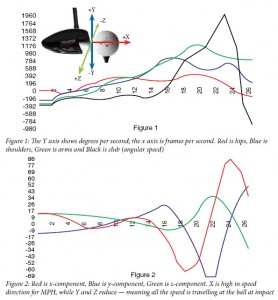
When I perform a biomechanics evaluation on a golfer’s swing, the most commonly asked first question is, “What is my club head speed?”
Typically, the player is interested in miles per hour (MPH). Most golfers relate distance to linear speed, because until recently, this was the only measurement of power. However, with the advent and accessibility of biomechanics technology we have the ability to measure club shaft and club head movement in three dimensions and objectively assess all of the components of power and speed during the swing. With this type of information, the golfer can actually measure the impact of his kinetic link on performance.
Concept
While the maximum linear speed of the club head is important to power and distance in the golf swing, it is not the only element involved when considering efficient movement. The rotational components of the motion are as crucial to efficiency as the linear components. The club head and the motion of the golf swing both have independent rotational and linear components that have to be considered when measuring power generated during the golf swing.
Rotational Components
As the club accelerates during the down swing it moves around the axis of the trunk, increasing in angular speed. Angular velocity is measured by the change in angle over time, or degrees per second. The body transfers energy from the big muscles of the lower body to the smaller muscles of the upper body creating a dramatic increase in rotation (see fig 1). As we discussed in the last article, the final link in generating rotational speed is the acceleration of the club away from the arms (club release). As the club releases, the angular velocity increases and can reach maximum velocities of up to 1700 degrees per second at impact in a tour level swing. This is why good club release is so important. More often than not, the less efficient swing reaches maximum angular velocity prior to impact, resulting in a decelerating club head, even though the linear speed or (MPH) is quite high. The result is a swing that takes incredible physical effort that may generate high MPH but, more often not, generates less distance.
Linear Components
Linear club head speed or MPH is also somewhat complicated. Remember that the club head travels in three dimensions. Although maximum total speed is important, the 3-D components of that speed are important as well. One way to picture the three components is as follows.
- Club head speed direction Up and down on the ball (Y component).
- Club head speed direction Inside to out and outside to in (Z component).
- The direction in which you are intending to drive the ball or “down the line” (X component).
The most important of these components is the speed of the club head “down the line” as it accelerates into impact with the ball. In the tour level swing, this component increases to a maximum level while the other components decrease (see fig 2). The result is maximum speed and energy which is focused in the direction of the intended flight at impact. In a less efficient swing, speed and energy is wasted in the other two components, which contributes to unwanted ball spin and errant ball striking.
Conclusion
The ability to generate power in the form of rotational and liner club head speed comes from an efficient kinetic link, learning how to better co-ordinate movement patterns increases our efficiency in delivering all the speed we generate from the power generation process from the ground to the ball at the point of impact.




![Win the golfing experience of a lifetime, at the Hawai‘i International Week of Golf, valued at $6,900 [Winner Announced] Win the golfing experience of a lifetime, at the Hawai‘i International Week of Golf, valued at $6,900 [Winner Announced]](https://www.insidegolf.com.au/wp-content/uploads/Hawaii-Comp-500x294.jpg)